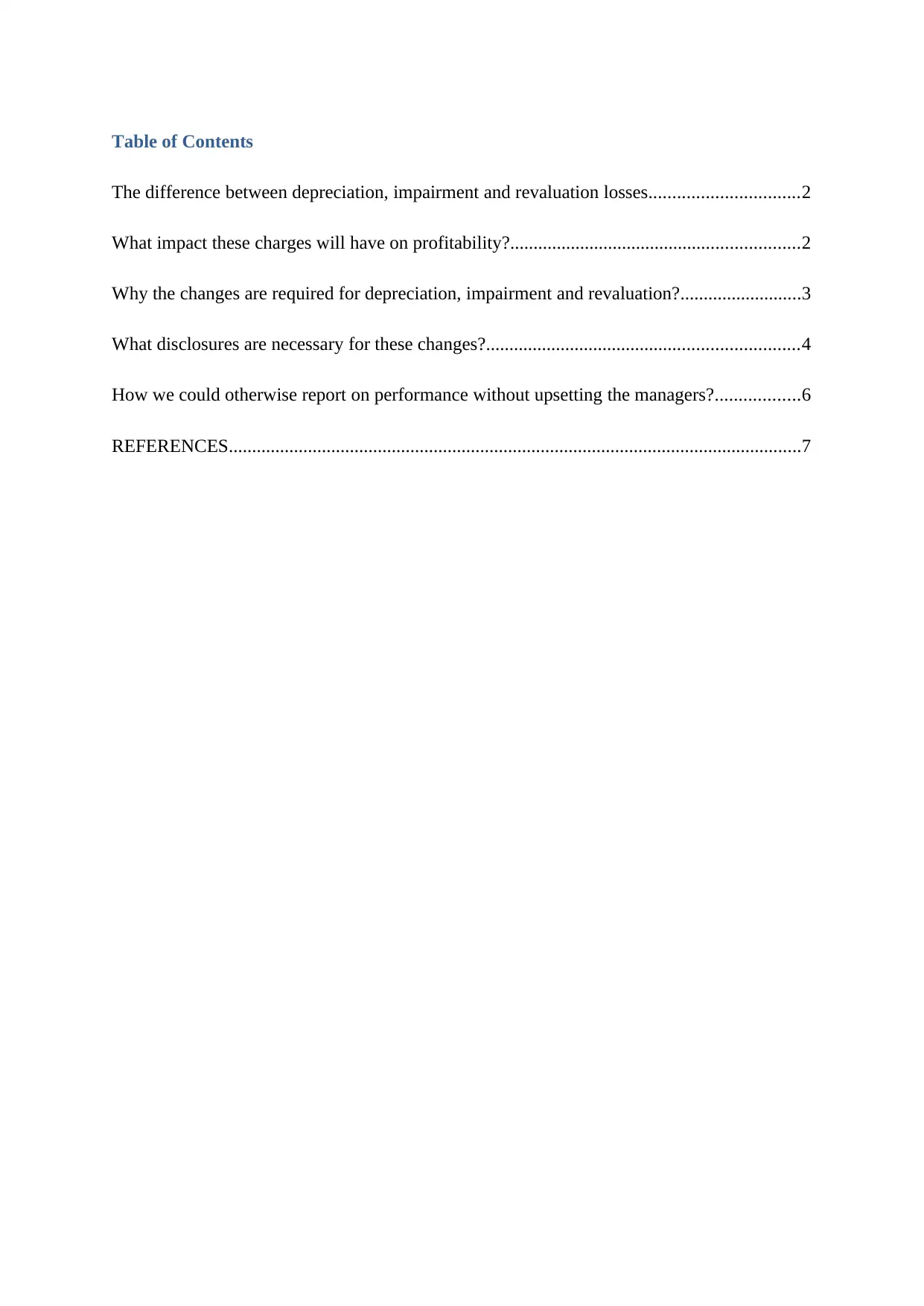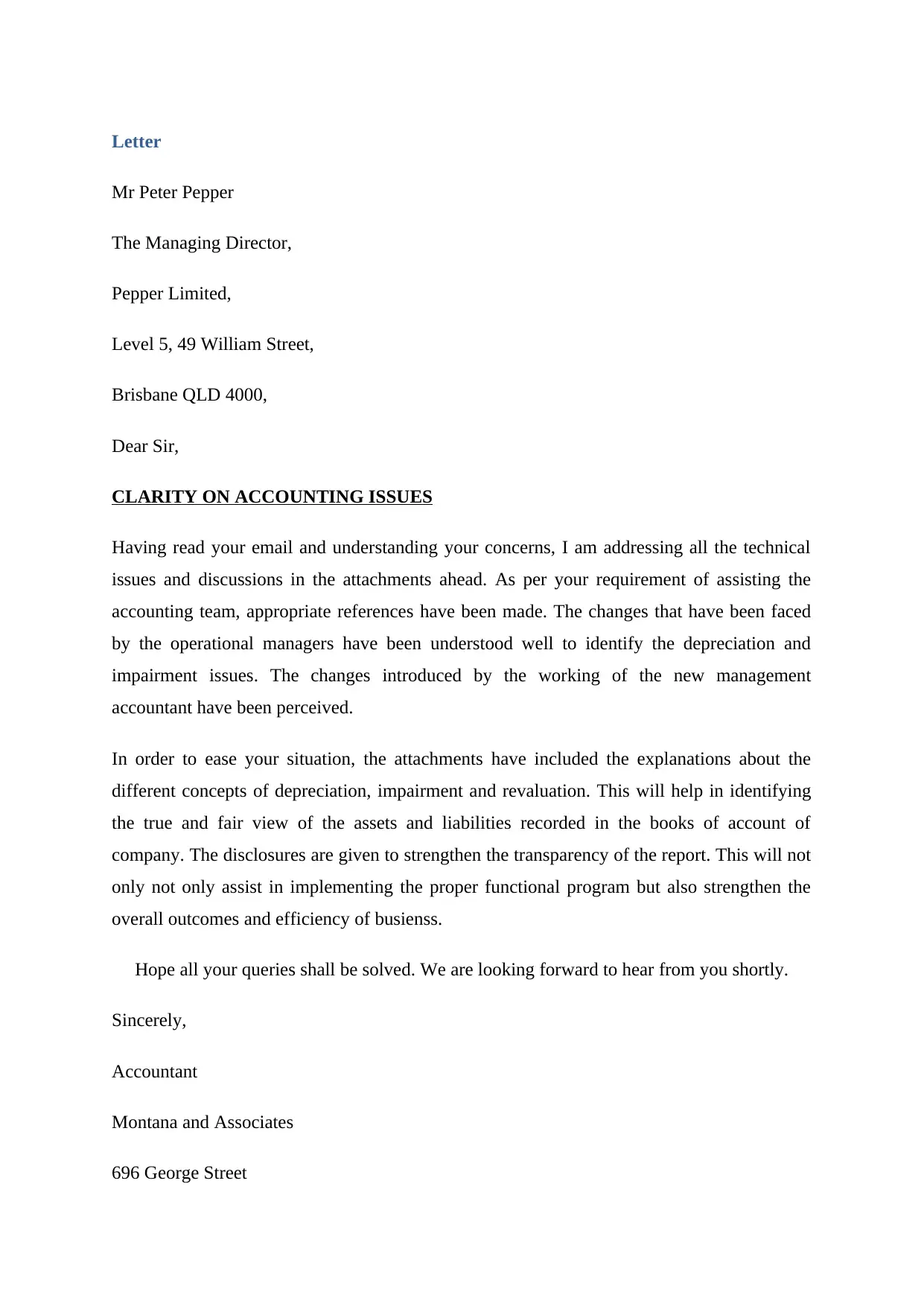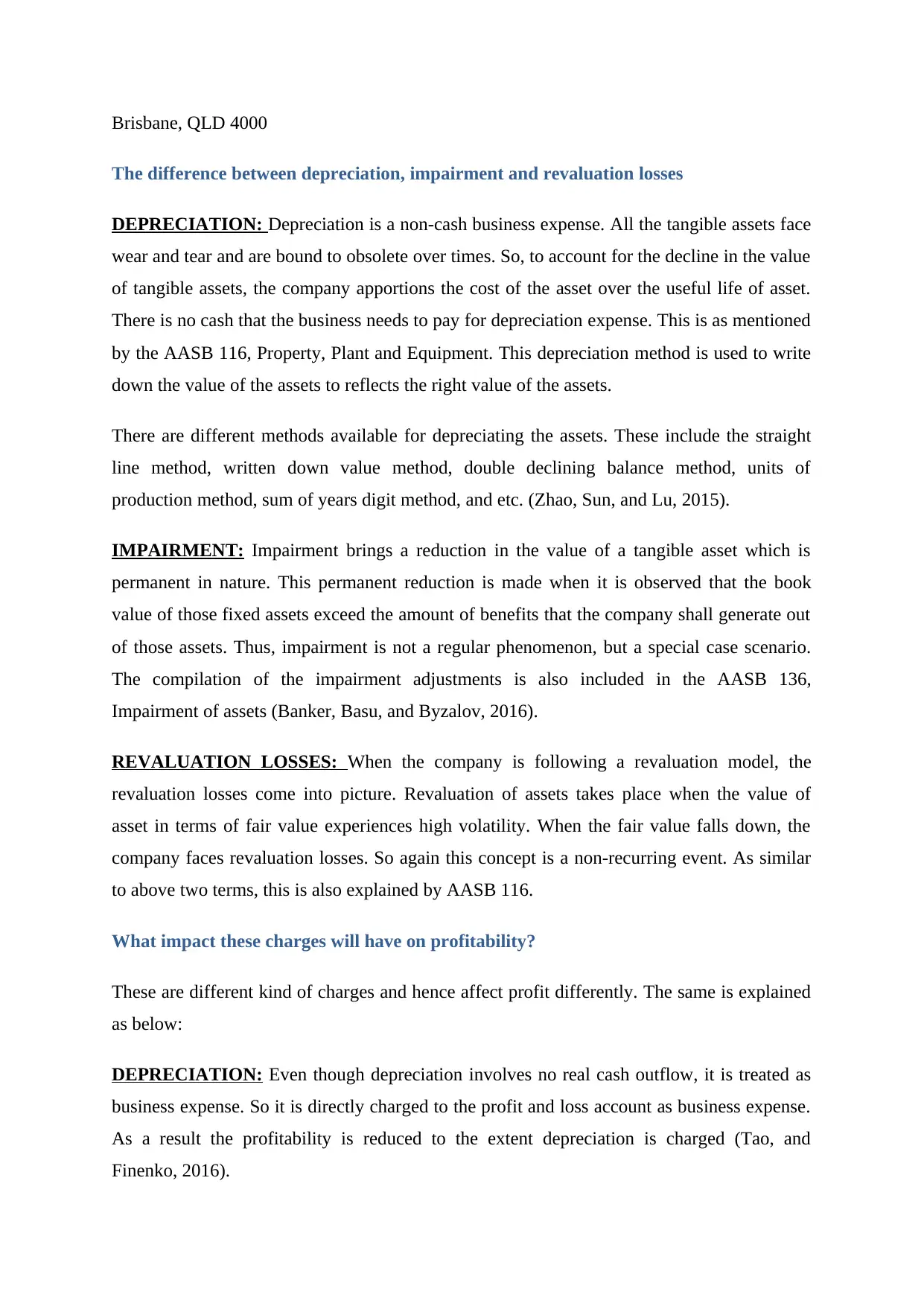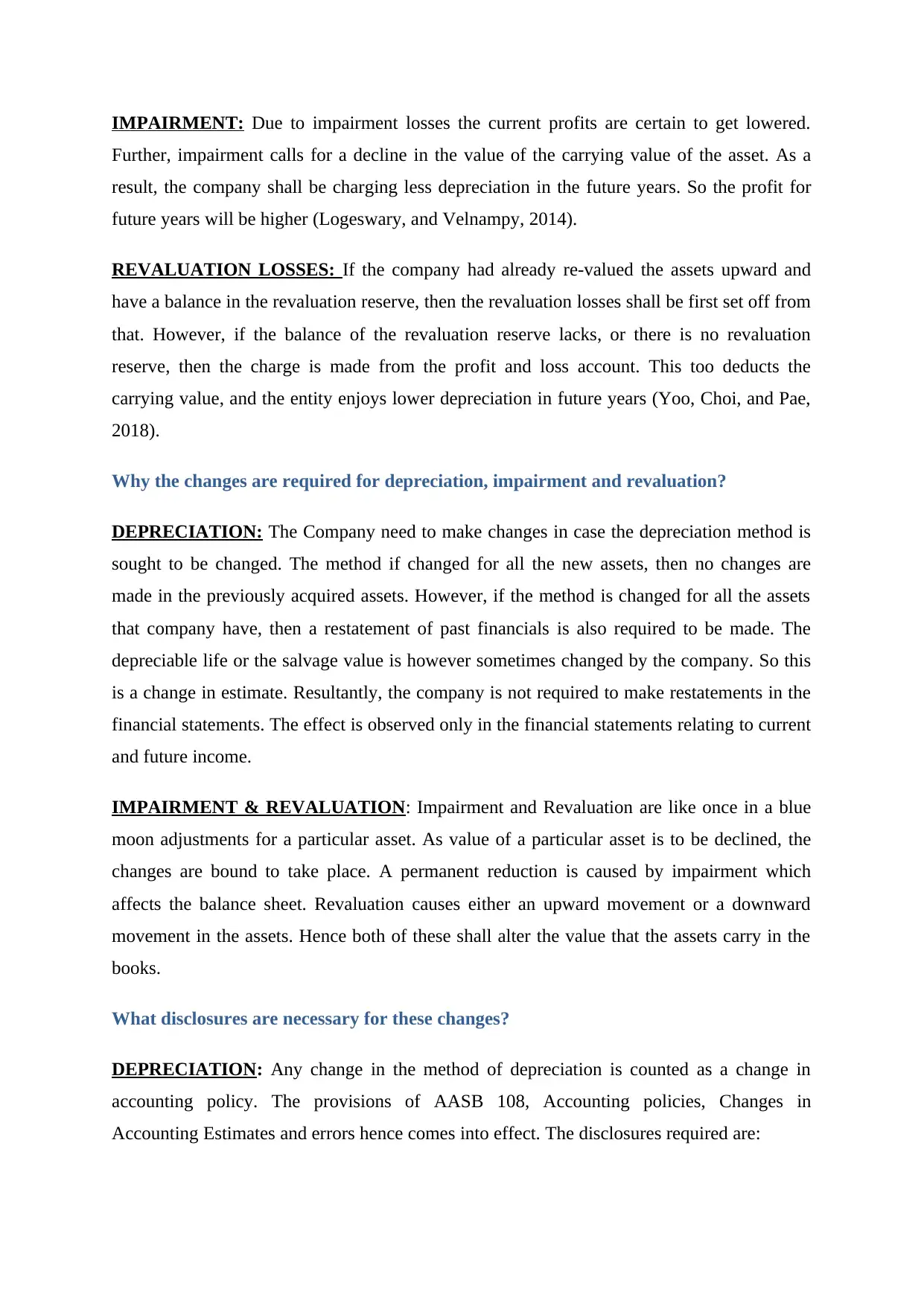Clarity on Accounting Issues: Depreciation, Impairment, and Revaluation
VerifiedAdded on 2023/06/08
|7
|1844
|220
AI Summary
This article provides clarity on accounting issues related to depreciation, impairment, and revaluation. It explains the difference between these concepts, their impact on profitability, why changes are required, necessary disclosures, and alternative reporting methods.
Contribute Materials
Your contribution can guide someone’s learning journey. Share your
documents today.

HEWLETT-PACKARD
CLARITY ON ACCOUNTING ISSUES
Accounting issues
Name of author
CLARITY ON ACCOUNTING ISSUES
Accounting issues
Name of author
Secure Best Marks with AI Grader
Need help grading? Try our AI Grader for instant feedback on your assignments.

Table of Contents
The difference between depreciation, impairment and revaluation losses................................2
What impact these charges will have on profitability?..............................................................2
Why the changes are required for depreciation, impairment and revaluation?..........................3
What disclosures are necessary for these changes?...................................................................4
How we could otherwise report on performance without upsetting the managers?..................6
REFERENCES...........................................................................................................................7
The difference between depreciation, impairment and revaluation losses................................2
What impact these charges will have on profitability?..............................................................2
Why the changes are required for depreciation, impairment and revaluation?..........................3
What disclosures are necessary for these changes?...................................................................4
How we could otherwise report on performance without upsetting the managers?..................6
REFERENCES...........................................................................................................................7

Letter
Mr Peter Pepper
The Managing Director,
Pepper Limited,
Level 5, 49 William Street,
Brisbane QLD 4000,
Dear Sir,
CLARITY ON ACCOUNTING ISSUES
Having read your email and understanding your concerns, I am addressing all the technical
issues and discussions in the attachments ahead. As per your requirement of assisting the
accounting team, appropriate references have been made. The changes that have been faced
by the operational managers have been understood well to identify the depreciation and
impairment issues. The changes introduced by the working of the new management
accountant have been perceived.
In order to ease your situation, the attachments have included the explanations about the
different concepts of depreciation, impairment and revaluation. This will help in identifying
the true and fair view of the assets and liabilities recorded in the books of account of
company. The disclosures are given to strengthen the transparency of the report. This will not
only not only assist in implementing the proper functional program but also strengthen the
overall outcomes and efficiency of busienss.
Hope all your queries shall be solved. We are looking forward to hear from you shortly.
Sincerely,
Accountant
Montana and Associates
696 George Street
Mr Peter Pepper
The Managing Director,
Pepper Limited,
Level 5, 49 William Street,
Brisbane QLD 4000,
Dear Sir,
CLARITY ON ACCOUNTING ISSUES
Having read your email and understanding your concerns, I am addressing all the technical
issues and discussions in the attachments ahead. As per your requirement of assisting the
accounting team, appropriate references have been made. The changes that have been faced
by the operational managers have been understood well to identify the depreciation and
impairment issues. The changes introduced by the working of the new management
accountant have been perceived.
In order to ease your situation, the attachments have included the explanations about the
different concepts of depreciation, impairment and revaluation. This will help in identifying
the true and fair view of the assets and liabilities recorded in the books of account of
company. The disclosures are given to strengthen the transparency of the report. This will not
only not only assist in implementing the proper functional program but also strengthen the
overall outcomes and efficiency of busienss.
Hope all your queries shall be solved. We are looking forward to hear from you shortly.
Sincerely,
Accountant
Montana and Associates
696 George Street

Brisbane, QLD 4000
The difference between depreciation, impairment and revaluation losses
DEPRECIATION: Depreciation is a non-cash business expense. All the tangible assets face
wear and tear and are bound to obsolete over times. So, to account for the decline in the value
of tangible assets, the company apportions the cost of the asset over the useful life of asset.
There is no cash that the business needs to pay for depreciation expense. This is as mentioned
by the AASB 116, Property, Plant and Equipment. This depreciation method is used to write
down the value of the assets to reflects the right value of the assets.
There are different methods available for depreciating the assets. These include the straight
line method, written down value method, double declining balance method, units of
production method, sum of years digit method, and etc. (Zhao, Sun, and Lu, 2015).
IMPAIRMENT: Impairment brings a reduction in the value of a tangible asset which is
permanent in nature. This permanent reduction is made when it is observed that the book
value of those fixed assets exceed the amount of benefits that the company shall generate out
of those assets. Thus, impairment is not a regular phenomenon, but a special case scenario.
The compilation of the impairment adjustments is also included in the AASB 136,
Impairment of assets (Banker, Basu, and Byzalov, 2016).
REVALUATION LOSSES: When the company is following a revaluation model, the
revaluation losses come into picture. Revaluation of assets takes place when the value of
asset in terms of fair value experiences high volatility. When the fair value falls down, the
company faces revaluation losses. So again this concept is a non-recurring event. As similar
to above two terms, this is also explained by AASB 116.
What impact these charges will have on profitability?
These are different kind of charges and hence affect profit differently. The same is explained
as below:
DEPRECIATION: Even though depreciation involves no real cash outflow, it is treated as
business expense. So it is directly charged to the profit and loss account as business expense.
As a result the profitability is reduced to the extent depreciation is charged (Tao, and
Finenko, 2016).
The difference between depreciation, impairment and revaluation losses
DEPRECIATION: Depreciation is a non-cash business expense. All the tangible assets face
wear and tear and are bound to obsolete over times. So, to account for the decline in the value
of tangible assets, the company apportions the cost of the asset over the useful life of asset.
There is no cash that the business needs to pay for depreciation expense. This is as mentioned
by the AASB 116, Property, Plant and Equipment. This depreciation method is used to write
down the value of the assets to reflects the right value of the assets.
There are different methods available for depreciating the assets. These include the straight
line method, written down value method, double declining balance method, units of
production method, sum of years digit method, and etc. (Zhao, Sun, and Lu, 2015).
IMPAIRMENT: Impairment brings a reduction in the value of a tangible asset which is
permanent in nature. This permanent reduction is made when it is observed that the book
value of those fixed assets exceed the amount of benefits that the company shall generate out
of those assets. Thus, impairment is not a regular phenomenon, but a special case scenario.
The compilation of the impairment adjustments is also included in the AASB 136,
Impairment of assets (Banker, Basu, and Byzalov, 2016).
REVALUATION LOSSES: When the company is following a revaluation model, the
revaluation losses come into picture. Revaluation of assets takes place when the value of
asset in terms of fair value experiences high volatility. When the fair value falls down, the
company faces revaluation losses. So again this concept is a non-recurring event. As similar
to above two terms, this is also explained by AASB 116.
What impact these charges will have on profitability?
These are different kind of charges and hence affect profit differently. The same is explained
as below:
DEPRECIATION: Even though depreciation involves no real cash outflow, it is treated as
business expense. So it is directly charged to the profit and loss account as business expense.
As a result the profitability is reduced to the extent depreciation is charged (Tao, and
Finenko, 2016).
Secure Best Marks with AI Grader
Need help grading? Try our AI Grader for instant feedback on your assignments.

IMPAIRMENT: Due to impairment losses the current profits are certain to get lowered.
Further, impairment calls for a decline in the value of the carrying value of the asset. As a
result, the company shall be charging less depreciation in the future years. So the profit for
future years will be higher (Logeswary, and Velnampy, 2014).
REVALUATION LOSSES: If the company had already re-valued the assets upward and
have a balance in the revaluation reserve, then the revaluation losses shall be first set off from
that. However, if the balance of the revaluation reserve lacks, or there is no revaluation
reserve, then the charge is made from the profit and loss account. This too deducts the
carrying value, and the entity enjoys lower depreciation in future years (Yoo, Choi, and Pae,
2018).
Why the changes are required for depreciation, impairment and revaluation?
DEPRECIATION: The Company need to make changes in case the depreciation method is
sought to be changed. The method if changed for all the new assets, then no changes are
made in the previously acquired assets. However, if the method is changed for all the assets
that company have, then a restatement of past financials is also required to be made. The
depreciable life or the salvage value is however sometimes changed by the company. So this
is a change in estimate. Resultantly, the company is not required to make restatements in the
financial statements. The effect is observed only in the financial statements relating to current
and future income.
IMPAIRMENT & REVALUATION: Impairment and Revaluation are like once in a blue
moon adjustments for a particular asset. As value of a particular asset is to be declined, the
changes are bound to take place. A permanent reduction is caused by impairment which
affects the balance sheet. Revaluation causes either an upward movement or a downward
movement in the assets. Hence both of these shall alter the value that the assets carry in the
books.
What disclosures are necessary for these changes?
DEPRECIATION: Any change in the method of depreciation is counted as a change in
accounting policy. The provisions of AASB 108, Accounting policies, Changes in
Accounting Estimates and errors hence comes into effect. The disclosures required are:
Further, impairment calls for a decline in the value of the carrying value of the asset. As a
result, the company shall be charging less depreciation in the future years. So the profit for
future years will be higher (Logeswary, and Velnampy, 2014).
REVALUATION LOSSES: If the company had already re-valued the assets upward and
have a balance in the revaluation reserve, then the revaluation losses shall be first set off from
that. However, if the balance of the revaluation reserve lacks, or there is no revaluation
reserve, then the charge is made from the profit and loss account. This too deducts the
carrying value, and the entity enjoys lower depreciation in future years (Yoo, Choi, and Pae,
2018).
Why the changes are required for depreciation, impairment and revaluation?
DEPRECIATION: The Company need to make changes in case the depreciation method is
sought to be changed. The method if changed for all the new assets, then no changes are
made in the previously acquired assets. However, if the method is changed for all the assets
that company have, then a restatement of past financials is also required to be made. The
depreciable life or the salvage value is however sometimes changed by the company. So this
is a change in estimate. Resultantly, the company is not required to make restatements in the
financial statements. The effect is observed only in the financial statements relating to current
and future income.
IMPAIRMENT & REVALUATION: Impairment and Revaluation are like once in a blue
moon adjustments for a particular asset. As value of a particular asset is to be declined, the
changes are bound to take place. A permanent reduction is caused by impairment which
affects the balance sheet. Revaluation causes either an upward movement or a downward
movement in the assets. Hence both of these shall alter the value that the assets carry in the
books.
What disclosures are necessary for these changes?
DEPRECIATION: Any change in the method of depreciation is counted as a change in
accounting policy. The provisions of AASB 108, Accounting policies, Changes in
Accounting Estimates and errors hence comes into effect. The disclosures required are:

Whether the change is made according to the transitional provisions and description or
explanation of the transitional provisions
accounting policy’s nature of change
the changes effected in the line items of financial statements and the earning per share as per
AASB 133, Earnings Per Share.
And in case there is impracticability in the retrospective application of the change, the
reasons are to be specified and the period from which change is effected is to be mentioned.
The figure of adjustment belonging to previous periods (Ball, Hoberg, and Maksimovik,
2015). It assists in identifying the impairment loss and revaluating the recorded assets and
liabilities in its books of accounts.
This adjustment will assist in revaluating the assets and reflecting the true and fair views of
the assets and liabilities to its stakeholders.
REVALUATION:
The increment or decrement in the assets due to revaluation
A reconciliation statement of the carrying amount of asset (Sellhorn, and Stier, 2018)
Identifying the true and fair value of the assets and liabilities recorded in the books of
account.
IMPAIRMENT:
A reconciliation statement of the carrying amount of asset
Impairment losses that got charged to profit and loss
Impairment losses reversed from the profit and loss (André, Dionysiou, and Tsalavoutas,
2018).
How we could otherwise report on performance without upsetting the managers?
BALANCED SCORECARD METHOD can be used as a better evaluation technique.
This technique shall evaluate performance not just by the earnings. The criteria shall involve
other aspects like the revenue affected, the share price attained and the satisfied customer
base. This way the change in profitability due to changes in policies by the new accountant
shall not upset the managers (Hoque, 2014). This approach will assist in evaluating the four
aspects of the business to identify how well company has been performing in market.
explanation of the transitional provisions
accounting policy’s nature of change
the changes effected in the line items of financial statements and the earning per share as per
AASB 133, Earnings Per Share.
And in case there is impracticability in the retrospective application of the change, the
reasons are to be specified and the period from which change is effected is to be mentioned.
The figure of adjustment belonging to previous periods (Ball, Hoberg, and Maksimovik,
2015). It assists in identifying the impairment loss and revaluating the recorded assets and
liabilities in its books of accounts.
This adjustment will assist in revaluating the assets and reflecting the true and fair views of
the assets and liabilities to its stakeholders.
REVALUATION:
The increment or decrement in the assets due to revaluation
A reconciliation statement of the carrying amount of asset (Sellhorn, and Stier, 2018)
Identifying the true and fair value of the assets and liabilities recorded in the books of
account.
IMPAIRMENT:
A reconciliation statement of the carrying amount of asset
Impairment losses that got charged to profit and loss
Impairment losses reversed from the profit and loss (André, Dionysiou, and Tsalavoutas,
2018).
How we could otherwise report on performance without upsetting the managers?
BALANCED SCORECARD METHOD can be used as a better evaluation technique.
This technique shall evaluate performance not just by the earnings. The criteria shall involve
other aspects like the revenue affected, the share price attained and the satisfied customer
base. This way the change in profitability due to changes in policies by the new accountant
shall not upset the managers (Hoque, 2014). This approach will assist in evaluating the four
aspects of the business to identify how well company has been performing in market.

REFERENCES
André, P., Dionysiou, D. and Tsalavoutas, I., 2018. Mandated disclosures under IAS 36
Impairment of Assets and IAS 38 Intangible Assets: value relevance and impact on analysts’
forecasts. Applied Economics, 50(7), pp.707-725.
Ball, C., Hoberg, G. and Maksimovic, V., 2015. Disclosure, business change and earnings
quality. 99(2), pp.44-77.
Banker, R.D., Basu, S. and Byzalov, D., 2016. Implications of Impairment Decisions and
Assets' Cash-Flow Horizons for Conservatism Research. The Accounting Review, 92(2),
pp.41-67.
Hoque, Z., 2014. 20 years of studies on the balanced scorecard: trends, accomplishments,
gaps and opportunities for future research. The British accounting review, 46(1), pp.33-59.
Logeswary, S. and Velnampy, T., 2014. Impact of Impairment Loss on Profitability and
Capital Structure of Listed Manufacturing Companies in Sri Lanka.., 93(12), pp.41-67.
Sellhorn, T. and Stier, C., 2018. Fair value measurement for long-lived operating assets:
Research evidence. European Accounting Review, 93(2), pp.84-87.
Tao, J.Y. and Finenko, A., 2016. Moving beyond LCOE: impact of various financing
methods on PV profitability for SIDS. Energy Policy, 98, pp.749-758.
Yoo, C.Y., Choi, T.H. and Pae, J., 2018. Demand for fair value accounting: The case of the
asset revaluation boom in Korea during the global financial crisis. Journal of Business
Finance & Accounting, 45(1-2), pp.92-114.
Zhao, J., Sun, X. and Lu, C., 2015, July. The research on small express depreciation of fixed
assets in the road long-distance passenger transport. In Logistics, Informatics and Service
Sciences (LISS), 2015 International Conference on(pp. 1-5). IEEE.
André, P., Dionysiou, D. and Tsalavoutas, I., 2018. Mandated disclosures under IAS 36
Impairment of Assets and IAS 38 Intangible Assets: value relevance and impact on analysts’
forecasts. Applied Economics, 50(7), pp.707-725.
Ball, C., Hoberg, G. and Maksimovic, V., 2015. Disclosure, business change and earnings
quality. 99(2), pp.44-77.
Banker, R.D., Basu, S. and Byzalov, D., 2016. Implications of Impairment Decisions and
Assets' Cash-Flow Horizons for Conservatism Research. The Accounting Review, 92(2),
pp.41-67.
Hoque, Z., 2014. 20 years of studies on the balanced scorecard: trends, accomplishments,
gaps and opportunities for future research. The British accounting review, 46(1), pp.33-59.
Logeswary, S. and Velnampy, T., 2014. Impact of Impairment Loss on Profitability and
Capital Structure of Listed Manufacturing Companies in Sri Lanka.., 93(12), pp.41-67.
Sellhorn, T. and Stier, C., 2018. Fair value measurement for long-lived operating assets:
Research evidence. European Accounting Review, 93(2), pp.84-87.
Tao, J.Y. and Finenko, A., 2016. Moving beyond LCOE: impact of various financing
methods on PV profitability for SIDS. Energy Policy, 98, pp.749-758.
Yoo, C.Y., Choi, T.H. and Pae, J., 2018. Demand for fair value accounting: The case of the
asset revaluation boom in Korea during the global financial crisis. Journal of Business
Finance & Accounting, 45(1-2), pp.92-114.
Zhao, J., Sun, X. and Lu, C., 2015, July. The research on small express depreciation of fixed
assets in the road long-distance passenger transport. In Logistics, Informatics and Service
Sciences (LISS), 2015 International Conference on(pp. 1-5). IEEE.
1 out of 7
Your All-in-One AI-Powered Toolkit for Academic Success.
+13062052269
info@desklib.com
Available 24*7 on WhatsApp / Email
![[object Object]](/_next/static/media/star-bottom.7253800d.svg)
Unlock your academic potential
© 2024 | Zucol Services PVT LTD | All rights reserved.




